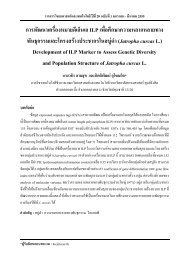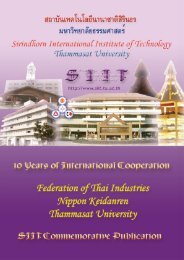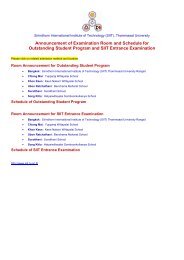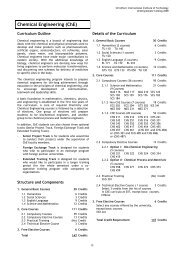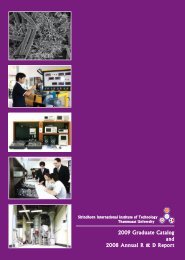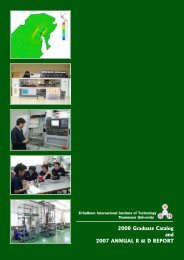2006 Graduate Catalog and 2005 Annual R & D Report - Sirindhorn ...
2006 Graduate Catalog and 2005 Annual R & D Report - Sirindhorn ...
2006 Graduate Catalog and 2005 Annual R & D Report - Sirindhorn ...
You also want an ePaper? Increase the reach of your titles
YUMPU automatically turns print PDFs into web optimized ePapers that Google loves.
<strong>2006</strong> <strong>Graduate</strong> <strong>Catalog</strong> <strong>and</strong> <strong>2005</strong> <strong>Annual</strong> R & D <strong>Report</strong><br />
<strong>Sirindhorn</strong> International Institute of Technology (SIIT)<br />
Research Interests:<br />
GA-based Design of Manual Assembly Lines with<br />
Respect to Productivity <strong>and</strong> Postural-Physical<br />
Loads Smoothness<br />
Traditionally, an assembly line is designed based on<br />
a single factor, namely, productivity. More<br />
specifically, the design problem involves the<br />
determination of the number of assembly<br />
workstations <strong>and</strong> the assignment of assembly tasks to<br />
individual workstations based on the given line<br />
throughput such that the balance delay is minimized.<br />
The worker-workstation assignments are normally<br />
fixed <strong>and</strong> the assembly tasks that workers have to<br />
perform are repetitive. For a manual assembly line,<br />
such requirements put workers at high risk of<br />
cumulative trauma disorders (CTDs) due to<br />
unbalanced postural <strong>and</strong> physical workloads on the<br />
musculoskeletal system of the body. This research<br />
project is intended to apply a genetic algorithm (GA)<br />
approach to the design of a manual assembly line<br />
such that system productivity <strong>and</strong> postural-physical<br />
loads smoothness are concurrently optimized. The<br />
Rapid Upper Limb Assessment (RULA) technique is<br />
applied to ergonomically evaluate the postural <strong>and</strong><br />
physical loads imposed by individual assembly tasks.<br />
The project seeks to explain the chromosome<br />
encoding, evaluation procedure, crossover, mutation,<br />
<strong>and</strong> selection procedure to generate new generations<br />
that are superior to the previous ones. The results<br />
from the GA-based design procedure will yield the<br />
number of workstations <strong>and</strong> the worker-workstation<br />
assignments for the assembly line.<br />
Performance Analysis of Ergonomics-based<br />
Manual Assembly Line with Parallel Workstations<br />
<strong>and</strong> Floaters<br />
It has been long known that manual assembly tasks<br />
are repetitive <strong>and</strong> require the use of specific muscles<br />
in the upper extremities, creating excessive postural<br />
<strong>and</strong> physical loads on the excessively used body<br />
members. As a result, manual assembly line workers<br />
are at high risk of cumulative trauma disorders in the<br />
upper extremities. When ergonomics concerns are<br />
introduced to the manual assembly line balancing<br />
problems to assign assembly tasks to workers to<br />
achieve the maximum postural-physical loads<br />
smoothness, the resulting task-workstation<br />
assignment solution must be determined using an<br />
ergonomics-based approach. Unfortunately, the line<br />
throughput is likely to decrease since the balance<br />
delay of the line might be compromised. This<br />
research project is intended to investigate the effect<br />
of adding parallel workstations to some potential<br />
bottleneck workstations <strong>and</strong> providing floaters (or<br />
extra helpers) to those parallel workstations so as to<br />
increase the assembly line productivity. Additionally,<br />
several strategies for opening parallel workstations<br />
<strong>and</strong> rotating floaters among them will be investigated<br />
with respect to various desired throughput rates. The<br />
Rapid Upper Limb Assessment (RULA) technique will<br />
be used to assess the postural <strong>and</strong> physical loads<br />
imposed on the musculoskeletal system of the body<br />
when performing each manual assembly task. A<br />
heuristic procedure will be employed to assign<br />
assembly tasks to workstations using a mixed<br />
productivity <strong>and</strong> ergonomics consideration. Based on<br />
predefined dispatching strategies to assign floaters<br />
<strong>and</strong> rotate them among parallel workstations,<br />
simulation models will be developed. The<br />
performance of the given manual assembly line under<br />
different throughput rate requirements <strong>and</strong><br />
operational conditions will be analyzed. The variables<br />
of interest include: throughput rate, number of fulltime<br />
workstations, number of parallel workstations,<br />
number of floaters, dispatching strategy, <strong>and</strong><br />
switchover strategy. The performance indices are:<br />
achieved throughput rate, balance delay, utilization<br />
rates of full-time <strong>and</strong> parallel workstations, switchover<br />
rates, <strong>and</strong> average queue lengths at full-time<br />
workstations.<br />
Ergonomics-based Workforce Scheduling for the<br />
Vehicle Routing Problem<br />
The vehicle routing problem is intended to determine<br />
the optimal number of vehicles to delivery goods<br />
between finite sets of origins <strong>and</strong> destinations, <strong>and</strong><br />
their delivery routes. There are numerous variants of<br />
the vehicle scheduling problem that have been<br />
studied by operations research <strong>and</strong> industrial<br />
engineering researchers. However, very few (if any)<br />
have paid attention to the vehicle drivers. In realworld<br />
situations, vehicle drivers might not only drive<br />
delivery vehicles but also perform loading <strong>and</strong><br />
unloading of goods at both the origins <strong>and</strong><br />
destinations. With limited time windows,<br />
loading/unloading operations may require more than<br />
one person to perform. Moreover, long-distance<br />
driving is stressful <strong>and</strong> increases the risk of highway<br />
accidents. Alternate drivers may be required for<br />
certain delivery routes. This research project is<br />
intended to take the loading/unloading workload <strong>and</strong><br />
long-distance driving into consideration when finding<br />
the optimal workforce schedule for the vehicle routing<br />
problem. Based on the given delivery loads (in terms<br />
of required energy costs) <strong>and</strong> the driving distances for<br />
individual delivery trucks, a heuristic approach will be<br />
developed to determine the minimum numbers of<br />
vehicles <strong>and</strong> operators (drivers <strong>and</strong> movers) <strong>and</strong> their<br />
delivery routes so as to minimize the total traveling<br />
distance without exceeding the recommended daily<br />
energy expenditure <strong>and</strong> driving distance.<br />
Decision Support System for Selecting the Noise<br />
Hazard Control Strategy<br />
This research project is intended to develop a<br />
decision support system (DSS) for selecting the noise<br />
hazard control strategy for any noisy workplace when<br />
the budget is fixed. The DSS program will consist of<br />
the database module, input module, computing<br />
module, <strong>and</strong> output module. The database module<br />
will contain noise source data, noise data, feasible<br />
noise control methods <strong>and</strong> their implementation costs,<br />
<strong>and</strong> worker locations. The input module will enable<br />
the user to enter the total noise control budget,<br />
allocated budget portions to the engineering approach<br />
<strong>and</strong> to the use of hearing protection devices (HPDs),<br />
<strong>and</strong> preferred noise control methods. The computing<br />
module will utilize the genetic algorithm (GA) <strong>and</strong><br />
heuristic approaches to optimally select the<br />
30




